Another blog is being written on the MARUM website.

(click icon to see the ship's actual position,
opens a new window and website)
End of blog: many thanks for following!
After four weeks at sea, having sailed about 3000 nautical miles, we can only conclude that cruise M140 was a memorable cruise. We have been very lucky with the weather and sea, did not have any material damage, managed to recover and re-deploy all the instruments that we wanted and have collected unique and very interesting samples.
We thank master Detlef and his entire crew for taking excellent care of us and for a very nice and fruitful collaboration. We hope to sail on board RV Meteor again soon!
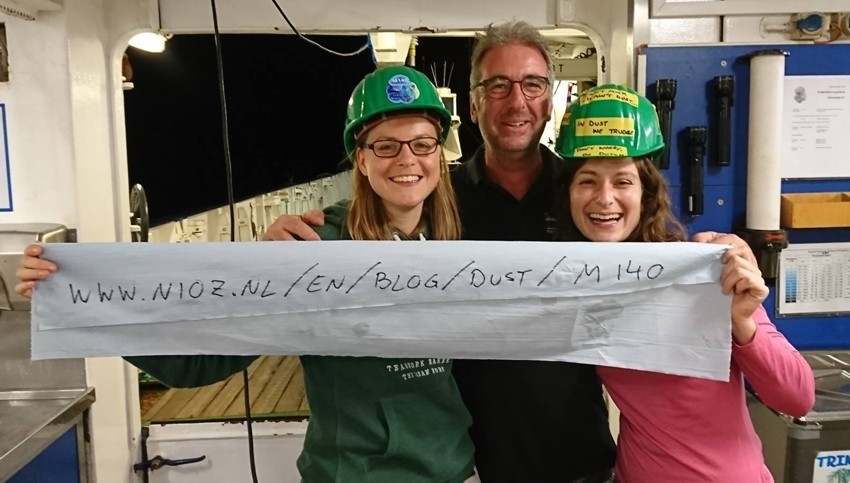
Tuesday 5 September: Last meal on deck
After having taking good care of us during the past four weeks with excellent meals, cooks Peter and Patrick have transferred their kitchen to the deck for a really nice barbecue. Michael, the ship's doctor, lends Patrick a hand at the fire where not only meat and vegetables are fried but also pieces of fresh fish that were caught at the three buoy positions. It is hard to find them better/fresher than this!
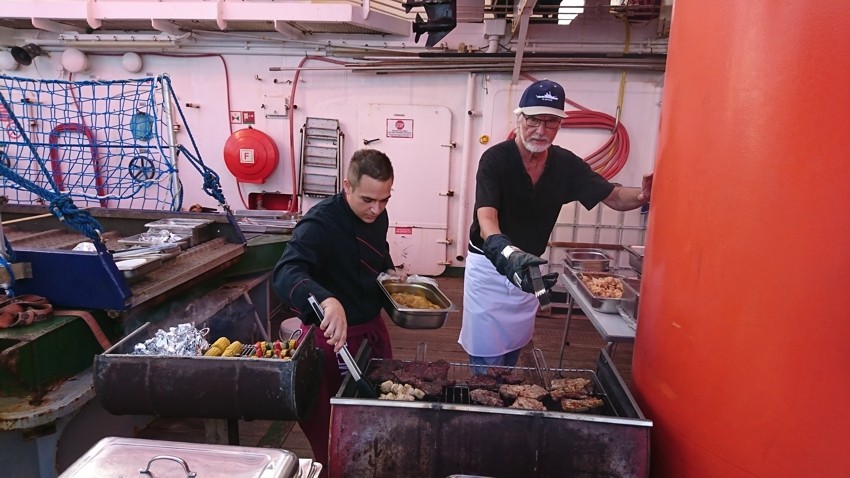
Monday 4 September: In she goes for another year of dust sampling!
After having cleaned the buoy, installed new filters and batteries, we re-deployed buoy Carmen for another year of dust sampling. The sampling interval is adjusted to the sampling interval with which the submarine sediment traps have been programmed so that sampling is synchronized completely. We intend to be back at this position during the upcoming expedition on board the Research Vessel Maria S. Merian, which is scheduled for October/November 2018. So far, buoy Carmen has "escaped" from her mooring line twice. To prevent another such escape we have now replaced the upper 350m nylon line with steel cable.
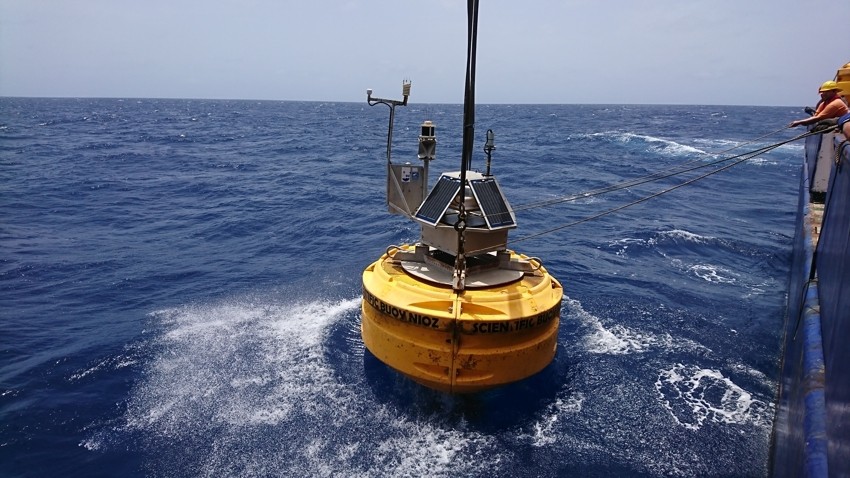
Sunday 3 September: Collecting dust with drifting traps
Next to all the moored instruments that have been collecting dust from the atmosphere as well as material settling through the water column (both dust and marine organic matter, remains of forams, coccolithophores, algae, etc.) with the sediment traps, we also sample the water column using so-called drifting traps. These traps consist of four perspex tubes that are suspended in the water; a weight at the tubes' lower ends keeps them upright so that material can sink into them. The traps are "free drifting", and the upper float is equipped with all kinds of beacons that allow us to find back the traps. We usually deploy them for a period of 24 hours so that we can compare the results with those obtained during previous cruises. They have given us a nice insight into the speed at which organic decomposes while sinking through the water column and also how this sinking is sped up by dust particles....
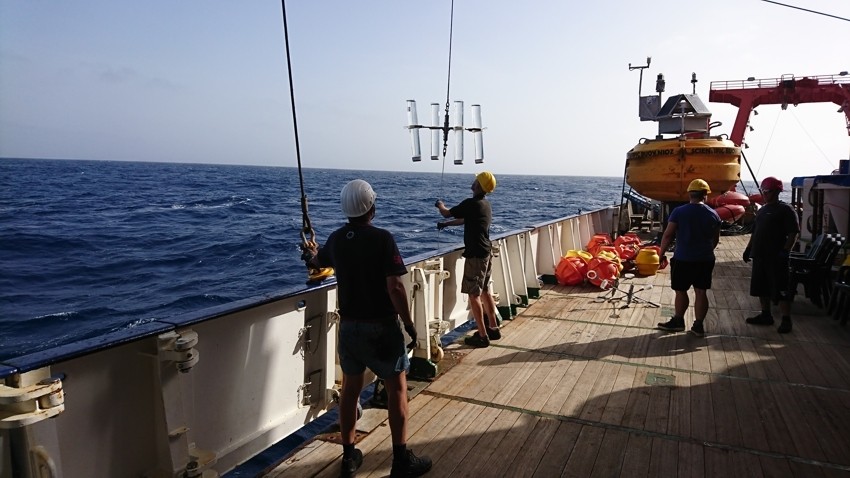
Saturday 2 September: Buoy Carmen covered in dust
It turns out that buoy Carmen has experienced quite some dust in the past six months! Literally the whole buoy is covered in an orange-brown crust. Here you see the --normally white-- Vaisala weather sensor being covered in dust. Even the spikes that are meant to prevent birds from landing on the weather station are completely covered in a brown crust. The salt from sea spray makes sure that the dust sticks everywhere. Next to these dust sticking all around the buoy, on smooth surfaces on the buoy such as the solar panels, there are also traces of dust that was washed down by rain. The filter interval was relatively short: 5-6 days, allowing for studying individual dust outbreaks. We can hardly wait being back in the lab to study all this material!
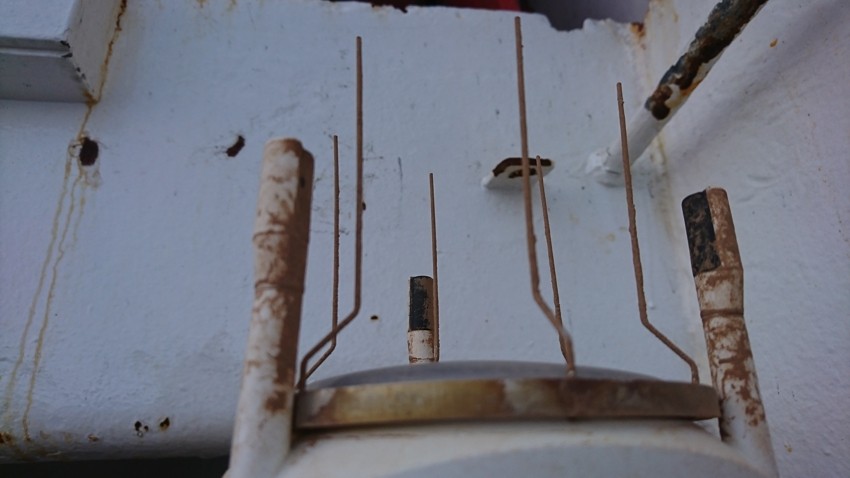
Friday 1 September: Recovering buoy Carmen
The last dust-monitoring station of this expedition is positioned about 200nm off the Mauritanian coast. Since 1988 the GEO-Bremen (now MARUM) group has been collecting settling material using sediment traps at this location. Such a long record is unique in the world and although initially the main focus was on marine organic material, it obviously also contains an excellent record of Saharan-dust deposition! Since 2013 we have equipped the station with dust-collecting buoy Carmen, sampling dust from the atmosphere in sync with the sediment collection under water by the traps.
Here you see how Carmen is being lifted out of the water. She had been deployed in February 2017 and during the past six months she has been covered with gooseneck barnacles and other marine animals. We obviously hope for some nice-and-dusty filters too!
Thursday 31 August: Alien from the deep
The main focus of most of this cruise’s participants is to study living planktic foraminifera, more specifically: how, where, and when in the water column do they grow and reproduce. This knowledge is of vital importance for the use of the calcium-carbonate shells that the plankton produce. If one can understand how the composition of the shells changes with changing oceanic conditions (water depth, temperature, salinity, etc.), one can potentially use these compositional changes in fossil foraminifera to reconstruct such oceanographic conditions in the past.
Planktic foraminifera vary in size from about 0.05mm up to 1 mm, and the mesh size of the nets that are used in the cruise for plankton sampling is 0.1mm. However, next to these small bugs, also larger creatures sometimes end up in the nets. Below you see a ~11cm Phronima, also known as “alien from the deep”. In fact, this parasitic animal –a crustacean, like shrimp and lobster—inspired the makers of the movie “Alien”.
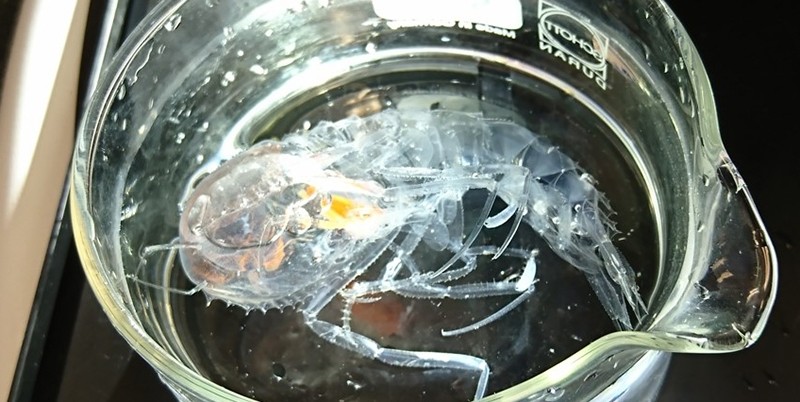
Wednesday 30 August: First-row spectators
Hoisting in heavy equipment is quite a sight and especially when there is a “first”, all the scientific crew are curiously lining up to see the new piece of equipment or to check if the instruments have performed well. It seems as such a crowd is also motivating for the crew on deck; they appear to do their extra best and make sure the whole procedure goes as smooth as possible. So far, we have a 100% score; all the equipment, including >120 multinet casts, was deployed and recovered safely and soundly: a big compliment to bosun Peter and his crew!
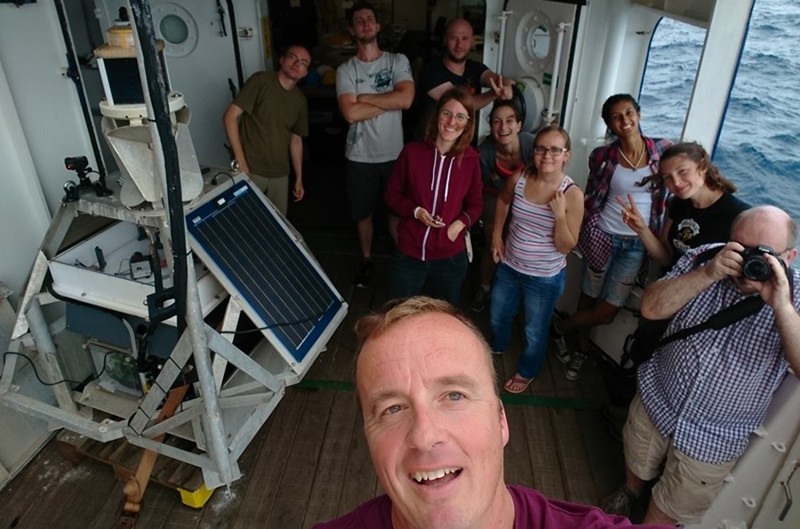
Tuesday 29 August: Leaving the rains
After leaving Mindelo some days ago and heading North, we have finally left the reach of the ITCZ. We will miss the beautiful high-rising convective clouds that literally scrape the skies. It is quite beautiful to see a rain cloud drift across the ocean. Less nice is the result of such tropical showers and everyone who is on deck regularly, unable to escape the rains, knows THE place to dry shoes; there is an air outlet from the machine room that blows hot air. Our record downpour brought down 38 mm of water in 25 minutes, which equals 38 litres per m²!! Only Jan-Berend seems to be happy with some rain now and then as they wash out large amounts of dust from the air…
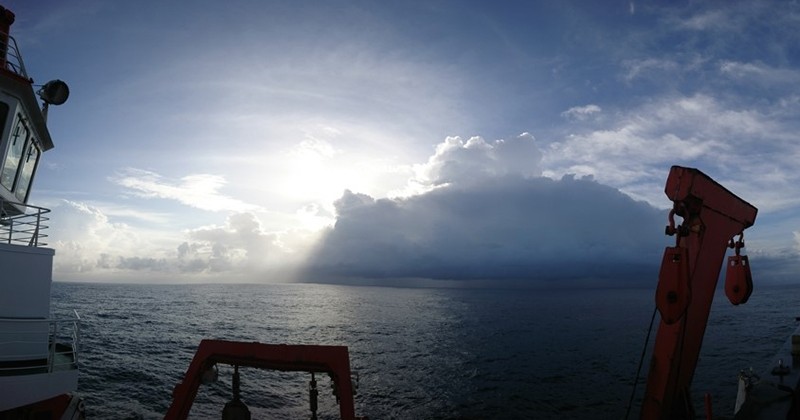
Monday 28 August: Wildlife
Around the buoys there is plenty of wildlife, including squids, Mai-Mais, Bonitos, sharks, and other fish. On the buoys themselves there are usually plenty of algae, gooseneck barnacles, and crabs. Other than these, wildlife is reduced to large scores of flying fish. Both the ship and –mostly invisible to us—predators scare them and their trick is to fly out of the water. They speed up, take a jump while spreading their wings and literally fly off. It is quite a sight to sometimes see whole scores of fish flying around! Unfortunately, they cannot really control where exactly they fly and some unlucky ones land on the deck of the ship. If we find them in time, we chuck them back into the ocean but for some it is too late…
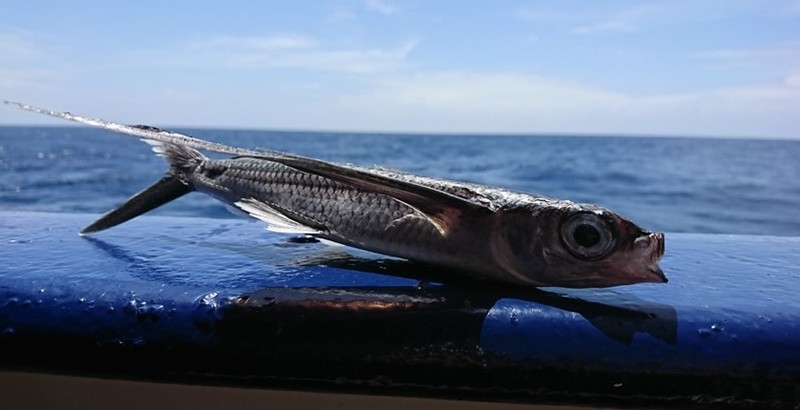
Sunday 27 August: Not always good weather…
To make our lives easier, we mount all kinds of tracking devices on the buoys so that we can find them back after deployment. The simplest one is a flasher, which is nicely visible in the night at a distance of up to 5 nautical miles (1 nm = 1.8km). In addition, there are so-called radio beacons that can be picked up by an antenna on the ship. This gives us a direction in which the floating device is, relatively to the ship, although not the distance. Finally, we have GPS devices that send their position to a mail address through the iridium satellite. As mostly the internet connection is OK, we can receive these mails and know exactly where to pick up the float.
Unless it’s raining….
On the photo below, you see how visibility is reduced to a couple hundreds of meters during a tropical rain shower. In such downpours, all of the fancy equipment has trouble sending out signals so we rely on the craftmanship of the officers on the bridge. So far, we always found our floats back: a big compliment to master Detlef and his officers Marco, Lena, and Benjamin!
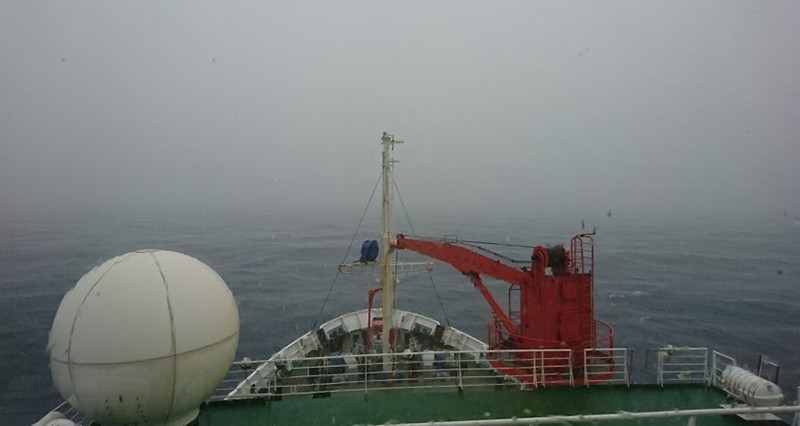
Saturday 26 August: Sailing the small Meteor
After having dropped three colleagues in Mindelo, and having picked up the MARUM sediment-trap group, we took an hour to bring out the two life boats. This manoeuvre is performed regularly in order to check the state of the small boats that may be our last resort in the unlikely event…. It also offers the opportunity to take a look at the Meteor from a different angle. The crew needed some people to man the lifeboats, and these volunteers were found easily!
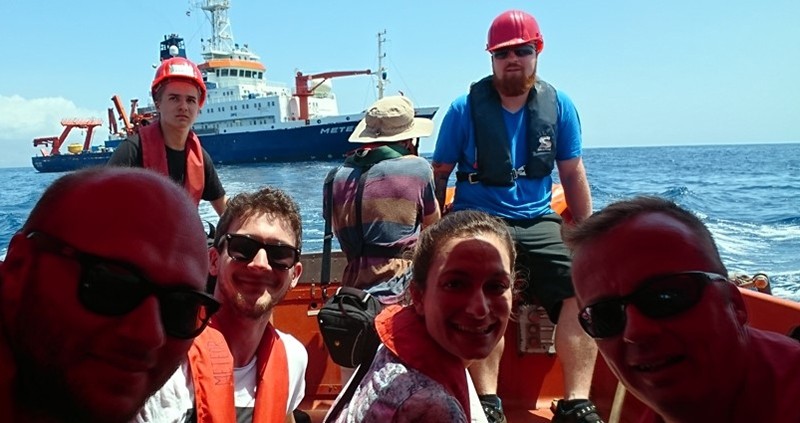
Friday 25 August: Buoy on deck!
Within the projects TRAFFIC (NWO-funded) and DUSTTRAFFIC (ERC-funded) we have constructed three dust-collecting buoys. These buoys are unique in the world. They were made at NIOZ, in close collaboration with the MARUM colleagues who have ample experience with buoys, and after a protoype that was kindly provided by Ed Sholkovitz from Woods Hole Oceanographic Institution. We are still developing the buoys; virtually at every deployment we implement improvements from lessons we’ve learned. During this cruise we will recover three buoys and re-deploy two of them. Here you see how buoys Laura is hoisted on deck. They are quite heavy things and require good coordination between the hoisting, securing, and handling.
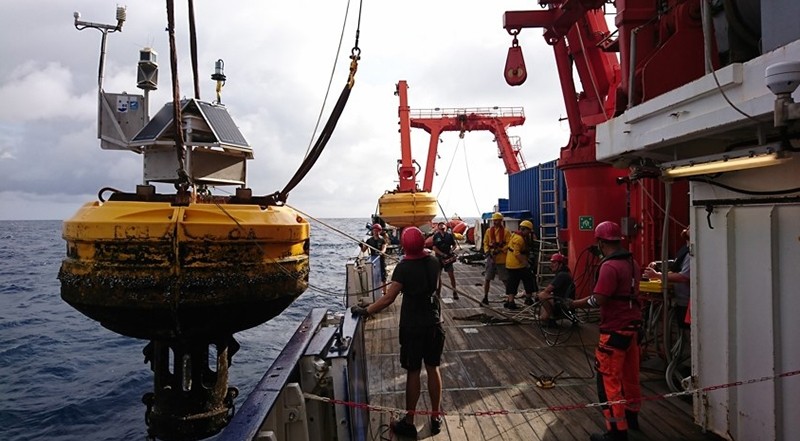
Thursday 24 August: Shipboard measurements
Most of the scientists on the ship are interested in studying the plankton, for which they use all kinds of microscopes. In addition, a lot of chemical properties of the water in which this plankton lives are analysed as well. A proper geochemical lab has been set up to this end, so that properties like salinity, dissolved inorganic Carbon – DIC, alkalinity (the amount of salts in the water, from which the CO2 content can be derived), and O2 content can be measured. In addition, samples are prepared for measurements at home in the lab, such as: oxygen isotopes, dD, nutrients, and also nannofossils.
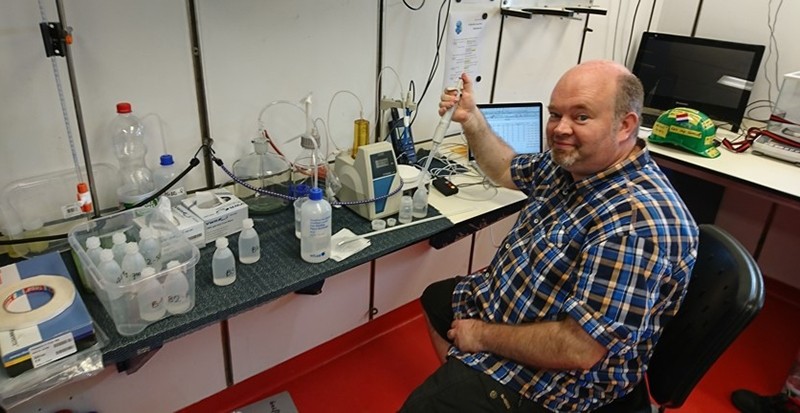
Wednesday 23 August: All hands on the bridge!
By far the most tense moments of recovering a mooring that has been 'out of sight' for a long period is that moment where we see it pop-up from the deep. The first things that come into sight are the floatation parts, which have bright colours for better visibility. Although we know exactly where the moorings' anchors are and can navigate to this spot within meters, on its way up to the surface, currents can deflect the mooring in any direction possible so that we will always have to search for it. It is not hard to find volunteers for this assignment; everybody is eager to be the first to spot the floats: all hands on the bridge!
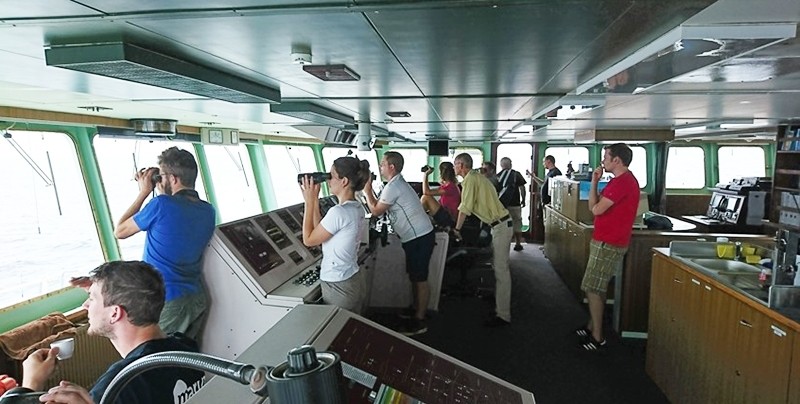
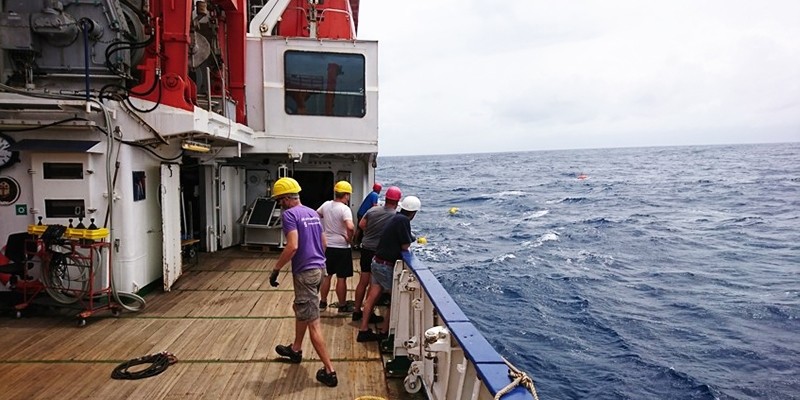
Tuesday 22 August: Trapped sediments
Both main stations of this cruise's first leg had a dust-collecting buoy and a mooring with sediment traps. Compared to the buoy, the success of these traps remains unclear until they are completely recovered. The buoys provide us with updates twice a day; through a satellite connection, they let us know where they are, what the weather is like and how the dust collection is progressing. The sediment traps, however, are below water and completely out of reach.
Prior to deployment, we have calculated how much time we want to cover in the sampling period (basically, we need to know when the pick-up cruise will be and divide that time by the amount of cups in the sediment-traps’ carrousel) and at what resolution we can sample the sediments that are settling through the ocean. The easiest way to determine if the traps have worked well is the amount of material in the cups that are on a carrousel below the funnel.
We can proudly state that we are doing very well during the cruise's first part; we have managed to recover all the traps and they have all functioned almost completely well! This gives a unique data set of high-resolution (down to four days!) samples, which we now 'only' have to process into data…
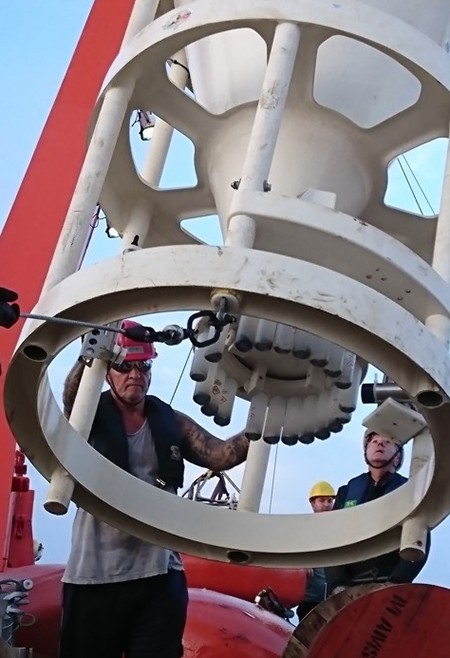
Monday 21 August: Hanging by a thread
The sediment-trap moorings have one strong positive feature: they stay under water. The buoys, however, are floating at the sea surface and potentially encounter all kinds of things flying, swimming, floating, or sailing by.
We noticed that the buoys create their own little habitats with a lot of fish. Maybe, this is the reason why there are practically always a lot of pieces of fishing gear dangling from the buoys' mooring lines. So far, these lines have not been able to cut through our mooring lines, but we realise how lucky we have been so far. Most of the line that we are using is made of 2.5cm thick nylon. The outer layer of the line is black so that fish won't see it that well, preventing them from being tempted to bite in our lines. On the picture below, you see how the nylon line is wound six times around the double capstan winch. On the far left, the black cover of the line is still intact, on the right, it is completely stripped off.
In the lower picture, you can see how the inner white nylon line is shredded almost completely; of the 2.5cm there is less than 1cm left in three 'core lines'. Most likely, a line has been eroding this piece of the line, almost cutting it through. Sometimes, we are lucky…
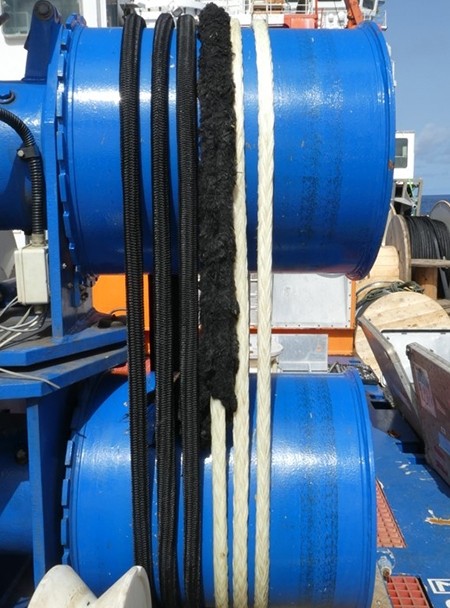
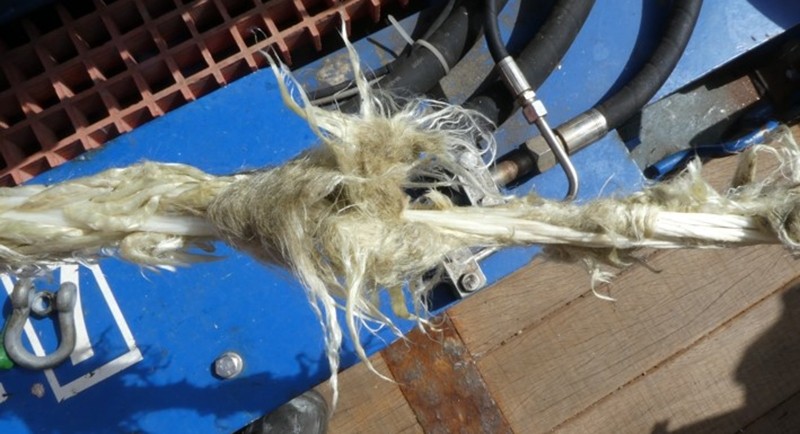
Sunday 20 August: Team work
Handling all the heavy equipment is really a specialists' job and requires well-coordinated teamwork. It is obvious that also in this field we are in good hands; Bosun Peter and his team clearly know what they are doing and they team up very well with Yvo, Jan-Dirk and Bob to handle sediment traps, buoys and other heavy gear. Not as much visible on deck but equally important is the team of master Detlef on the bridge: Lena, Benjamin and Marco. They handle the ship, making sure that it keeps position or sails at the right speed when required.
When planning such a logistically complicated task of recovering a sediment trap, one always assumes a certain duration, based on previous cruises, taking into account that the weather may not be always excellent and the waves could cause a 'rough ride'. So far, however, the 'guys on deck' have saved us a lot of time by running all operations very smoothly and successfully: true team work!
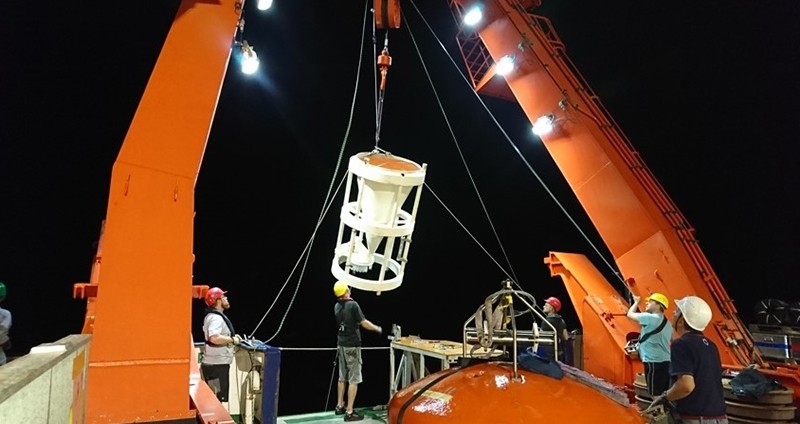
Saturday 19 August: Evening program
When at station we all work very long days, and the sampling of the water column is even done continuously in shifts throughout the night. During transits, however, we gather after dinner to get the latest updates from chief scientist Michal and to inform each other on our specific recent scientific findings. To this end, we gather in the conference room, which is nicely equipped with the necessary audio-visual equipment, including air conditioning. The latter can be cranked up when heated discussions between colleagues warms up the room….
Friday 18 August: Welcome to the tropics!
The study area is heavily influenced by the weather that is related to the InterTropical Convergence Zone (ITCZ). The ITCZ is the boundary between the Trades on both hemispheres and lies a tick north of the geographic equator ultimately owing to the northern hemisphere having more landmass than the southern one.
At this boundary, the northeast and southeast winds collide (converge), leading to low pressure = rising air. Being closest to the sun, the tropics obviously receive most energy and as a result, the oceans are very warm (the last days we consistently measured sea-water temperatures >28oC). The air just above the warm water is also warm and contains a lot of moisture (the last days we experienced humidities >70%). However, when these air masses rise at the ITCZ, they cool and water droplets are formed = clouds. Typically, the ITCZ can be recognised by huge and high-rising clouds, from which it “rains cats & dogs” regularly.
How is this related to dust? It turns out that moisture condenses out of the cooling air more easily when there are particles around. The dust particles act as so-called cloud condensation nuclei (CCN). This is a research discipline in itself and recent results found by colleagues at the TROPOS in Leipzig seem to indicate that the mineralogical composition is of great influence on cloud formation. Compositional changes of the dust throughout the year and along the transect across the Atlantic are thus of great interest, and we hope to shed light on these changes with our monitoring instruments.
Wednesday 17 August: Micro ecosystems
The oligotrophic (low in food) parts of the ocean that we sail through are sometimes called “the deserts of the sea” as there is so little life. The buoys, however, are creating micro-habitats of their own. The buoys provide shade and also a possibility for larvae to settle. Most often the buoys are completely covered in algae and gooseneck barnacles, which provide food for other animals such as crabs and worms. Also little fish profit from this unexpected food source in the middle of the ocean, and they are again part of a food chain that goes all the way to a 1.5m long Mai-Mai, which gets eaten by us, thanks to the fishing skills of the crew….
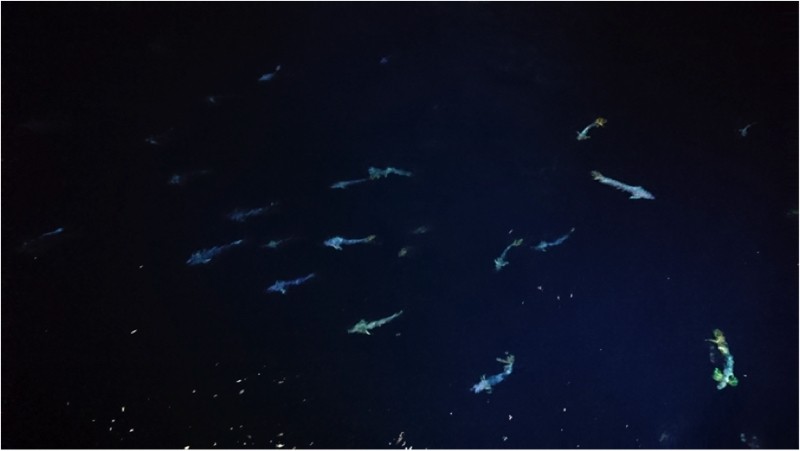
Tuesday 16 August: Buoy on deck!
At one of the main stations of this cruise, about halfway between Africa and the Caribbean, we collected buoy Michelle, which had been sampling Saharan dust since April 2016. In the night of Monday to Tuesday, we had approached the approximate position of buoy Michelle, from which we were getting updates by email twice a day. From about 7nm (nautical miles, 1nm = 1.8km) the buoy’s flasher could be seen already and within 6nm range she could be spotted on the ship’s radar. At dawn we then started recovery of the buoy, which went very smooth thanks to the calm weather –with some occasional tropical showers—and the excellent teamwork of bosun Peter and his crew with the NIOZ technicians Yvo and Jan-Dirk. Not only has the buoy been collecting Saharan dust, as a by-product it also contributed to many weather forecasts in countries around the Atlantic Ocean. The meteorological data that the dust buoys are collecting are stored in databases that are open to the public and as such certified observations in such remote places are rather scarce, they are being used by many Metoffices. In addition, the meteo-data that are generated on board FS Meteor, including twice-daily weather balloons, are also used around the world.
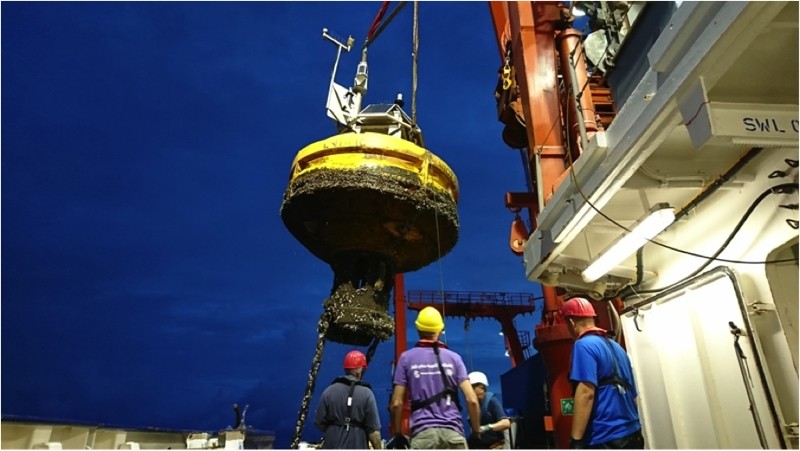
Sunday 14 August: Fishing for small bugs
By far the majority of this cruise’s participants (19 of 23) is interested in planktonic foraminifera: calcium-carbonate forming unicellular organisms that live in the surface ocean and that are about 100 – 300 micrometer “big”. The cruise is called FORAMFLUX for a reason. Their goal is to test a few hypotheses about how this plankton lives and reproduces. To collect the plankton, they are using a so-called multinet which consists of a metal frame that is lowered to the desired depth and then hauled up again. Behind the frame there are five nets, which can be closed remotely. This way, a vertical column of water can be sampled at any resolution. After collection, the samples are split and minutely studied with all kinds of microscopes. No less than 21 microscopes were brought to the ship. Bets are placed everyday how many specimen will be found today and some species have been found that were not expected in these waters in this season!
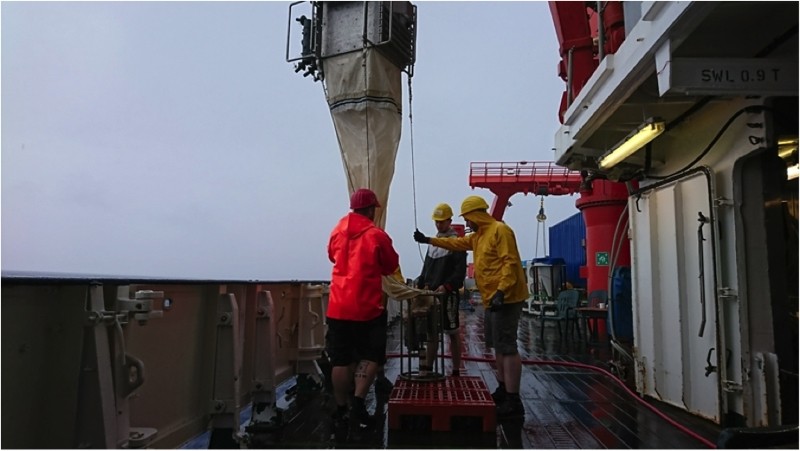
Sunday 13 August: Dust is in the air²!
The last few days we have been sailing through a light fog that turned out to be dust as was seen on the filters: a orange-brownish colouration that is typical for mineral dust. As our weather man Andreas predicted rain, and we suspect that actually most of the Saharan that ends up in the Atlantic Ocean is deposited by rain, we put up a very simple collection device: a grey box. The box is less than a m² and is 40cm so as to prevent material from splashing out again. As tropical rain showers can easily produce 70mm of water, the box was quite full with a tick less than 5 litres of water! What’s more; it was full of dust too!! On the picture you can see a lot of brown material, as if someone had chucked in a hand of dirt. This is actually dust that is washed out of the atmosphere!!
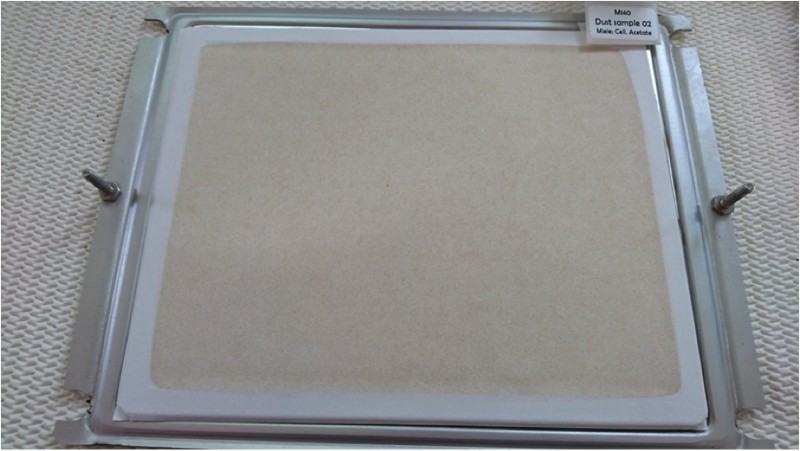
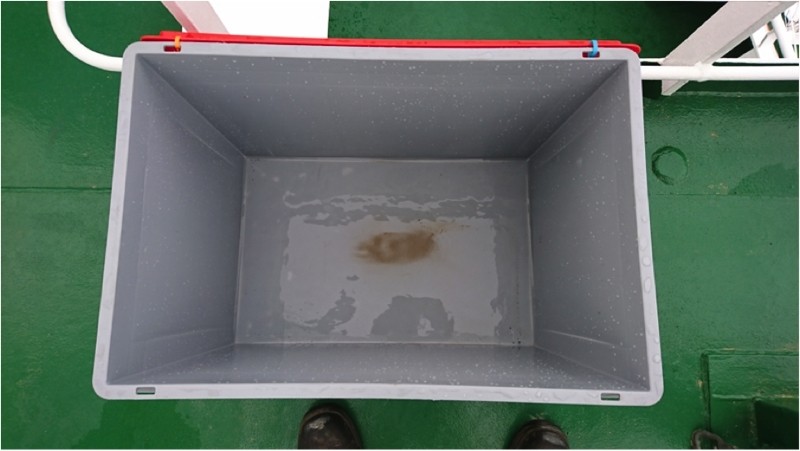
Saturday 12 August: Dust is in the air!
Andreas, the meteorologist of the German Metoffice (DWD) confirms our suspicions; the fog that we’re seeing over the ocean is actually Saharan dust! Visibility is reduced from a normal value of up to 20km down to a mere 9km.
The dust samplers that have been sucking air through A4-sized filters since yesterday also support this observation by showing a nice orange colouration which can only be mineral dust blown across the ocean from the Sahara. Recent satellite observations by colleagues from NASA have shown that each year about 180MTon dust are blown westward from the northwest African coast. From our own observations we conclude that a large share of this dust is actually deposited by rain and therefore, we hope to collect some dust-laden rains. After all, late summer is the time when rains occur in this part of the world although most cruise participants probably prefer some sunny weather…
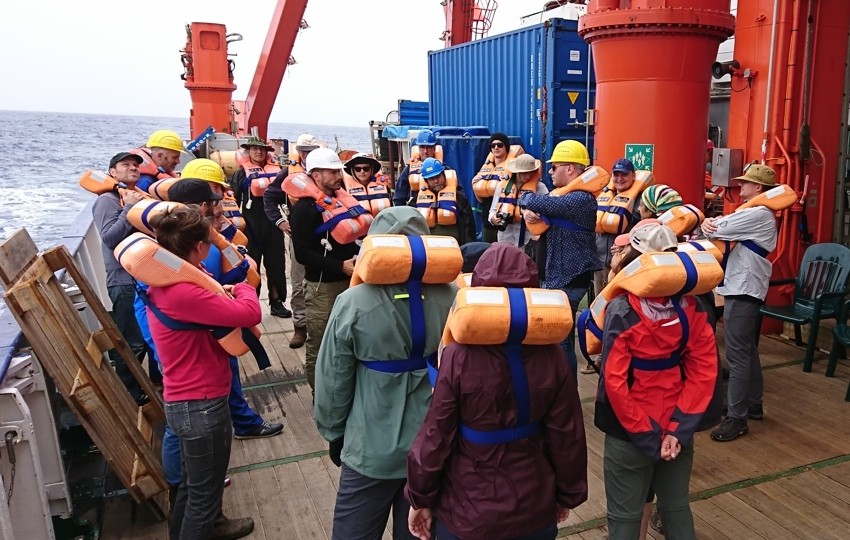 Friday 11 August: What if?
Friday 11 August: What if?
After leaving the harbour of Mindelo, we directly get all the instructions that we need in order to know what to do in case something goes wrong.
In the afternoon the instructions are put into practice during a safety drill in which we simulate an “abandon ship” manoeuvre. We all fetch our life jackets, don some warm protective clothing, and assemble at the muster station on deck. Again, the crew members clearly know what to do and they help and guide us towards the life boats.
We’re in good hands and feel taken care of very well. Still, the situation we’re practicing is something we’d rather avoid!
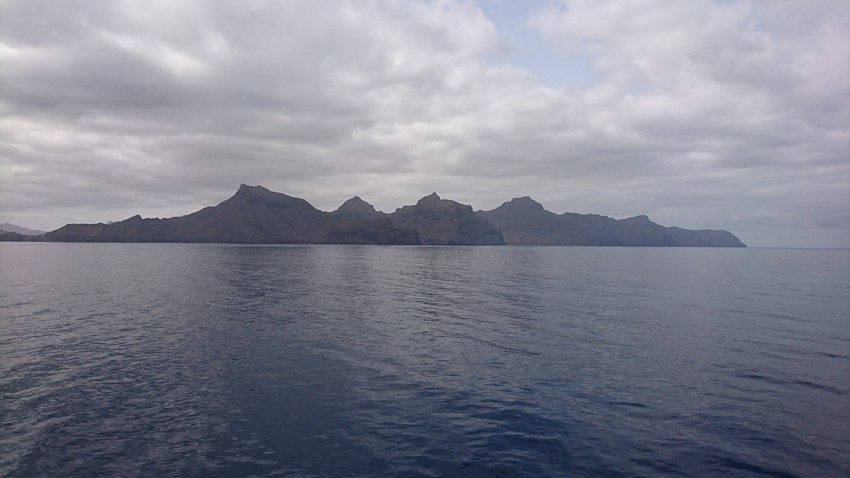 Friday 11 August: Leaving Sao Vicente
Friday 11 August: Leaving Sao Vicente
During the night, a ferry delivered the last piece of luggage so we’re good to go.
At 9AM, exactly according to schedule, the ship’s mooring lines are released and we’re off!
The excitement is omnipresent; we’re all keen to carry out the studies that we’ve been preparing for the last couple of months. It seems as Poseidon wishes us well; the weather is very friendly and the sea very calm.
The first multiple-day station lies about 1400 nautical miles westward and on the transit to this station we’ll do short stops to sample the water column. The dust samplers on the ship’s top deck are already sampling the atmosphere but the skies are very clear and seem devoid of Saharan dust.
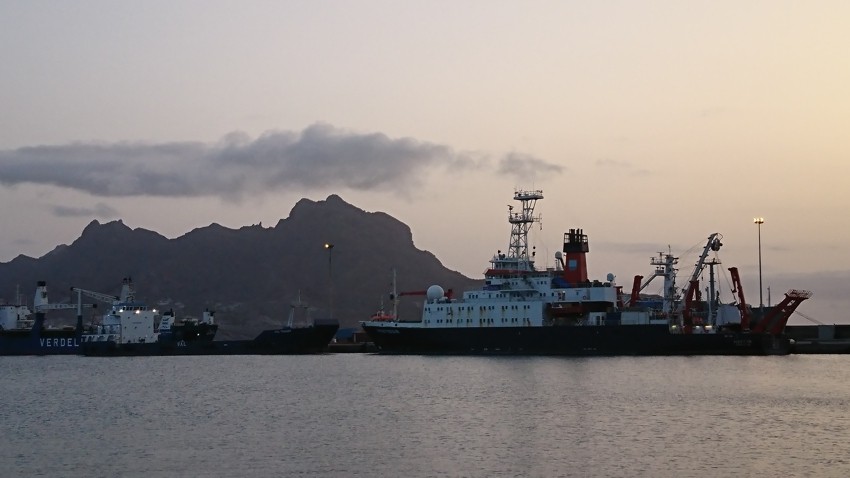 Thursday 10 August: A warm welcome on board
Thursday 10 August: A warm welcome on board
Directly after breakfast we were picked up by the agent and brought to the ship. Being back on RV Meteor feels a bit like coming home; many participants have joined previous cruises and therefore, meeting the crew and the other scientists feels a tick like a reunion.
Once on board, we start unpacking all the equipment that had been sent to Mindelo in sea containers already months ago and we try to get used to the life on a ship again. Labs are being assigned to the various groups and the dedicated pieces of equipment are installed and tested while winches and other larger gear is secured on deck.
Managing and feeding such a large group of people (24 scientific-, 33 ship crew) needs quite some organisation but the crew is clearly used to it; they are very friendly and doing their best to assist us wherever needed. Tomorrow we’ll be leaving in the early morning so in the evening practically everybody grabs the chance to walk around town for a bit for the last time in four weeks.